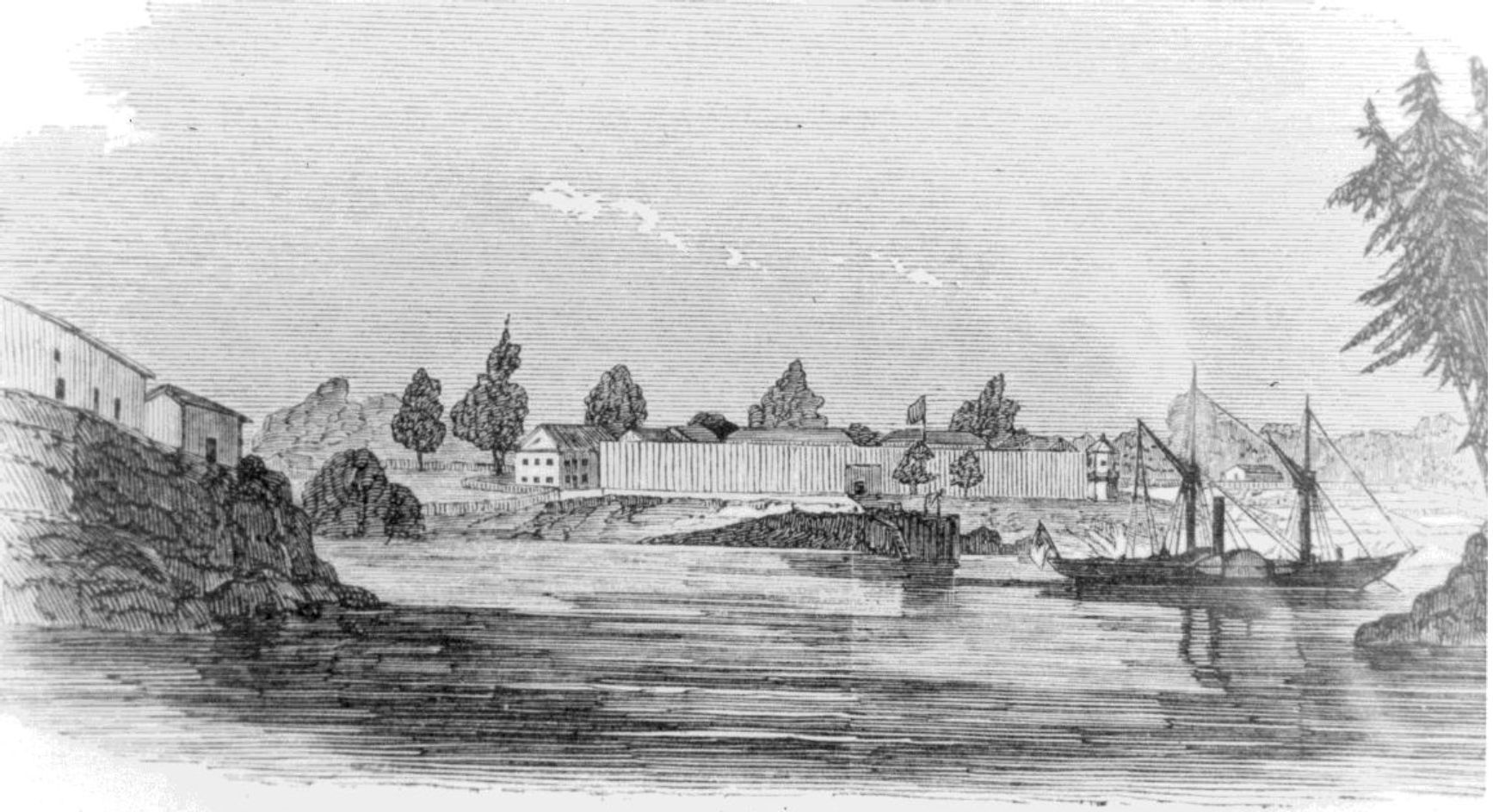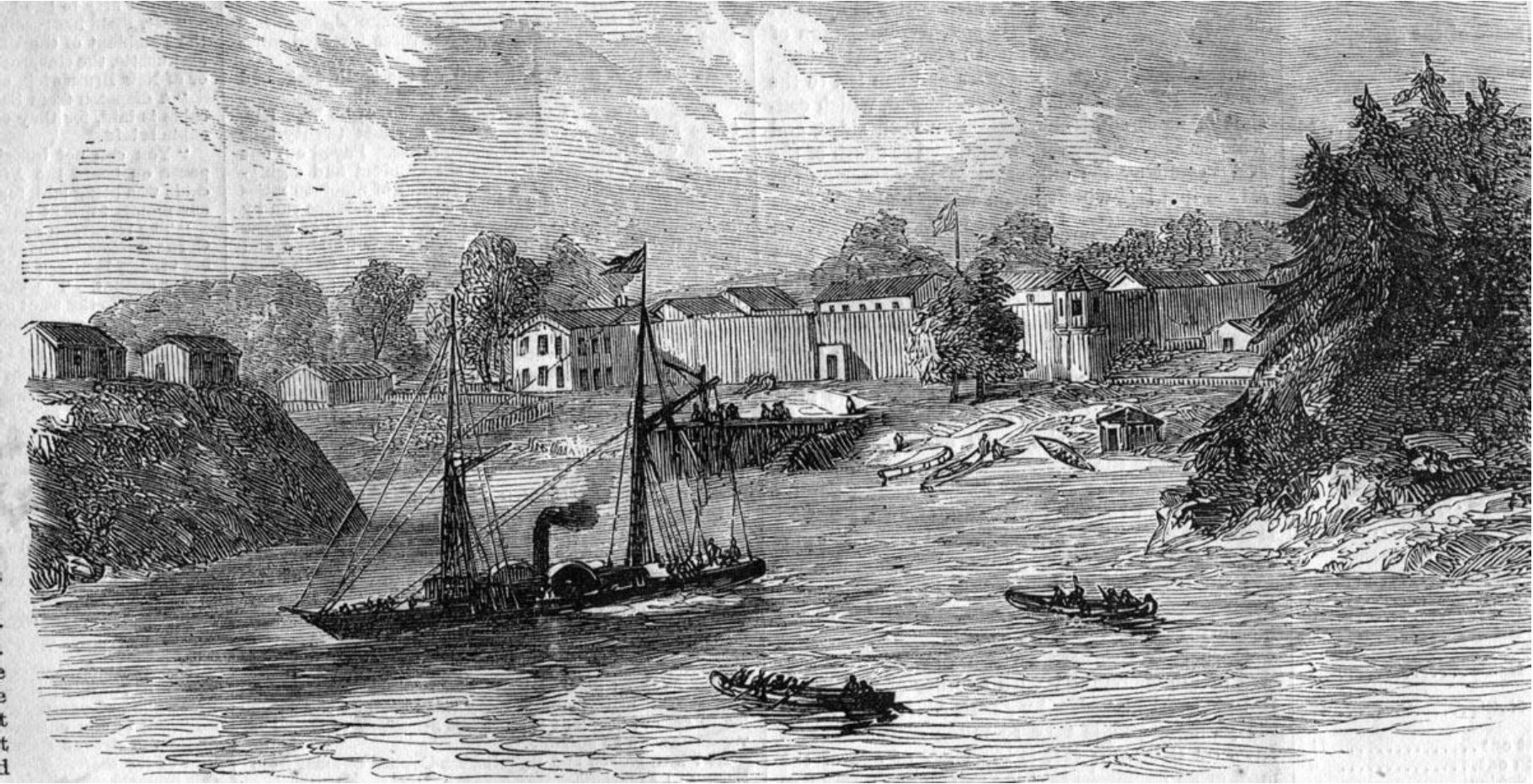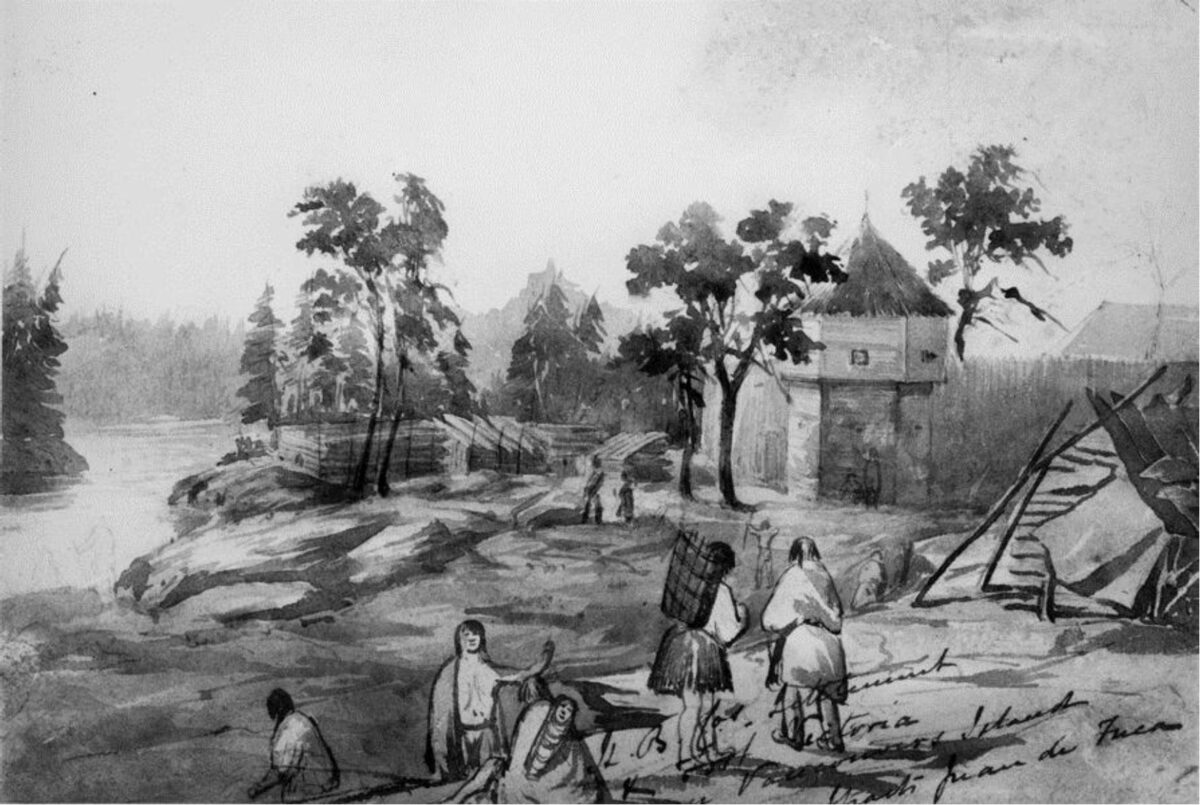By Grant Keddie. 2013.
Introduction
Captain Henry Warre, while on a spy mission for the British Government, painted a detailed water-color that shows the view looking north along the west side of Fort Victoria ( Figure 1). The image, painted on September 27, 1845, shows at least four traditional style First Nations plank houses adjacent to the Fort. The presence of these more permanent style plank houses has caused some confusion in the placing of various First Nations villages or encampments.

Other images of Fort Victoria drawn or painted around the same time period clearly show that these plank houses did not exist. Based on the available evidence it is clear that the plank houses painted by Henry Warre in 1845, along the west side of Fort Victoria were added in by Warre to enhance his painting. This seems surprising given that Warre was a military person concerned with documenting defensive security.
One of Henry Warre’s own drawings of September 27, 1845 (National Archives of Canada, C-058099) shows no First Nation post and beam plank houses outside the southwest end of the Fort – only a scribble of a small European style house and a First Nation hut off the S.W. corner of the Fort. The latter two can be seen in another of Warre’s sketchs from the south side of the Fort looking west (National Archives of Canada, C-058097).
His more detailed water-color (Warre Sketch #31) shows the above mat lodge hut, but also includes at least four non-existent traditional style plank houses. Images of the people in the foreground have been added to the painting.
Drawings by an Unknown Artist
A drawing of Fort Victoria by an unknown artist appeared as a wood engraving in the Illustrated London news on August 26, 1848 (RBCM Archives PDP00222)*. It does not show dwellings along the west side of the Fort. The engraving shows the Fort with the two new warehouses on the north side nearly completed. The extension of the Fort stockade which later enclosed these buildings has not been started.

Based on known construction dates of parts of the Fort, we can place the date of the original image to the time period after September 5, 1846 and before November 6, 1847. The project to build the two storage buildings, and extend the stockade of the Fort to enclose them, was underway on March 16, 1846. “We are now enlarging the Fort, and getting two additional buildings erected of 100X40 feet” (Letter of March 16, Peter S. Ogden and James Douglas to Sir George Simpson).We know from the commentary in the Victoria Fort Journals that the Storage houses were nearly finished on August 28th 1846, and the roof of the last store house completed on September 5th (Victoria Fort Journal). Between November 27, and December 23, 1847, the Stockade walls were being built and finished. The two bastions had extra floors added and were roofed by December 15, 1848. Missing from the wood cut image is the wheat storage building on stone piles in the harbour that was completed on November 6, 1847. This building can be seen in all later images.
Another wood engraving, likely from a drawing of the same unknown artist near the same time, was produced in Harper’s Weekly in 1858. This also shows no first Nations dwellings on the west side of the Fort.

Paul Kane’s Drawings
When Paul Kane visited the Fort Victoria region between April 8 and June 5, 1847, he observed that 10 non-aboriginal and 30 aboriginal people were engaged in building the new stores and warehouses.
The Paul Kane’s drawing of “Fort Victoria” (Landscape Log #82; Stark wwc104; Harper fig. 189) – A view taken from across the harbour to the west – does not show any aboriginal dwellings. Kane’s view of the Fort from the south, “Fort Victoria, with an Indian Village” (Harper, Fig. 188, p. 256) shows what appears to be a temporary style mat lodge near the S. W. corner of the Fort and two small building structures further along the south side of the Fort. The latter two are Fort related and not aboriginal structures. These can be seen in later images. At least one of Paul Kane’s paintings shows a woman weaving a blanket inside a temporary style mat lodge (Portrait Log # 64; Harper fig. 196, p. 261). It is possible this may have been done inside the mat lodge near the Fort but there is no evidence to substantiate this. There are no traditional First Nation post and beam style houses visible near the Fort in any of Paul Kane drawings. It therefore appears that Kane did his interior plank house drawings in houses on the Old Songhees Reserve rather than in houses on the Fort Victoria side of the Inner harbour.
I had earlier mistakenly suggested (Keddie 2003) that Paul Kane did some of his drawings of the interior of a plank house on the east side of the harbour, based on the strength of combined information from Staines statement about a village, Warre’s painting showing plank houses and Kane’s original field log that refers to the inside of a Clallam lodge in Victoria. Although I would still maintain that Kane’s original log book entries – as opposed to later composites and additions of information – are mostly correct.
Another place where a few of Kane’s paintings may have been done is in lodges located just inside Laurel Point that were known to be occupied by both Clallam and Lekwungen people (see Keddie 2003). Kane could also have been drawing in houses on the Old Songhees Village occupied by Clallam people. In general, Kane seemed to know the difference between people who were “Clallam” and “Sanges”, however, I think Kane, also was, on occasion, just using the term Clallam in a very general sense – as others did – to refer to the larger group of related peoples on the south end of Vancouver Island, some of the Gulf Islands and the Olympic Peninsula.
The early settler and surveyor Walter Colquhoun Grant, who lived in Sooke only a few years after Kane’s visit, dividing up the four aboriginal language groups and their variety of dialects on Vancouver Island. In doing so, he referred to the Clallam as the group extending from Sooke to Saanich (Grant 1857). Gibbs, also writing in the 1850s stated: The Klallam I consider to be another branch of the Selish, .. .Their opposite neighbors of Vancouver Island, the Soke or Tshoke of Soke Inlet, and the Tsong or Songhe of Victoria belong to the same connection” (Gibbs 1877).
More drawings were done in 1848 that also show no evidence of buildings on the west side of the Fort. Two were produced in August 1848, by John Turnstall Haverfield (RBCM Archives PDP 04464 and PDP01183) and one drawing in November by Ilya Gavrilovich Voznesenskii (catalogue #1142) in the Russian Academy of Sciences (Blomkvist 1972).
*A later drawing made from this 1848, wood cut was done by Peter M. O’Leary (NAC, C-562). Library and Archives Canada documented that O’Leary prepared drawings of Canadian historical interest dated c. 1854-71 that he copied from items in the Illustrated London News.
References
Blomkvist, E.E. 1972. A Russion Scientific Expedition to California and Alaska, 1839-1849. The Drawings of I.G. Voznesenskii. Translated by Basil Dmytryshyn and E.A.P Crownhart-Vaughan. Oregon Historical Quarterly, 73:2:101-170.
Harper, Russell J. 1971. Paul Kane’s Frontier. Including Wanderings of an Artist among the Indians of North America by Paul Kane. Edited with a Biographical Introduction and a Catalogue Raisonne by J. Russel Haper. The Amon Carter Museum, Fort Worth, and the National Gallery of Canada, Ottawa, University of Toronto Press, Toronto.
Keddie, Grant. 2003. Songhees Pictorial. A History of the Songhees People as seen by Outsiders, 1790-1912. Royal B.C. Museum, Victoria.
